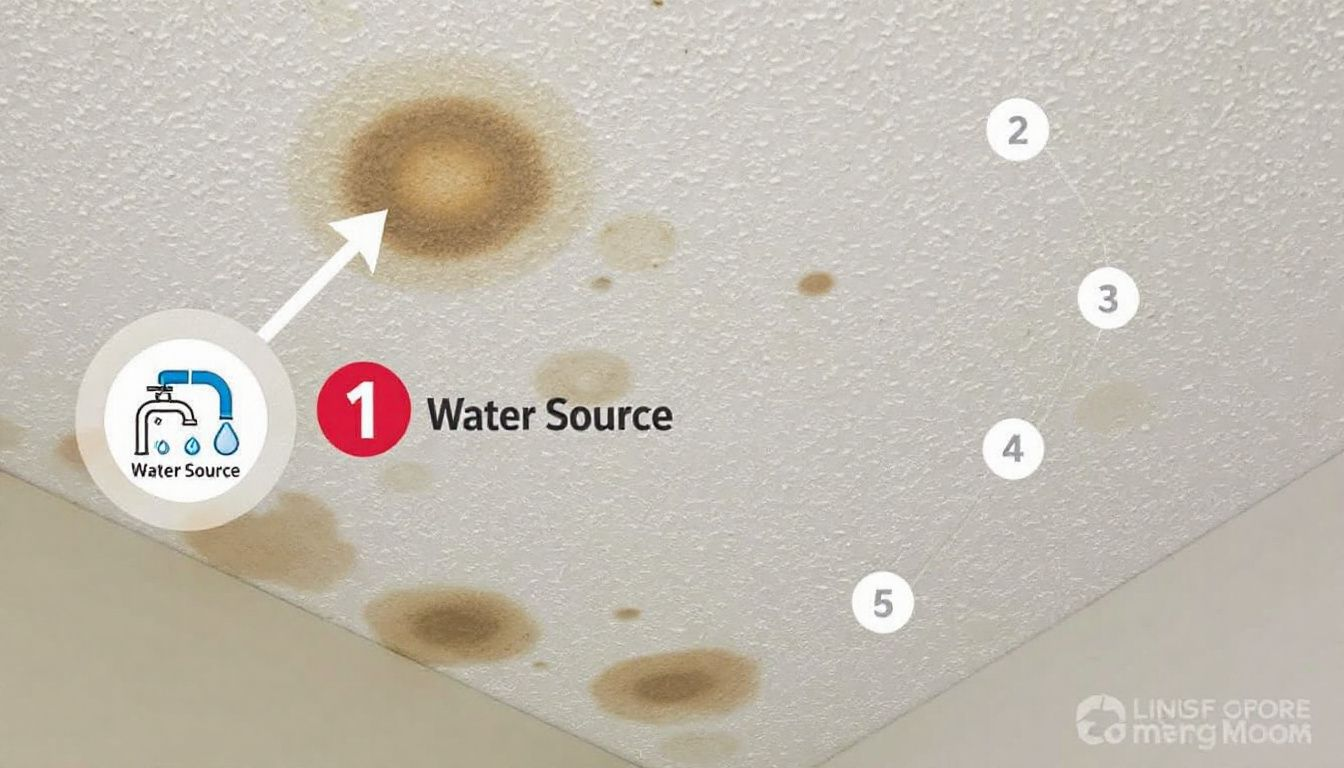
Water Damage Restorations
Call 1-202-883-6367
Top Signs to Help Identify What Does Water Damage Look Like
Water damage often appears as stains, bubbling paint, or mold. You might also notice musty smells or hear dripping sounds. Understanding what does water damage look like is crucial, and this article will guide you through the signs of water damage, helping you take action before it worsens.
Key Takeaways
- Water stains, bubbling wallpaper, and peeling paint are primary indicators of water damage and should be addressed promptly to prevent structural issues.
- High humidity levels and musty odors can signal hidden moisture problems, potentially leading to mold growth and health risks if not investigated.
- Regular inspections of plumbing fixtures and monitoring utility bills can help detect leaks early, preventing significant water damage and costly repairs.
Recognizing Water Stains and Discoloration

Water stains on walls or ceilings are often the first visible sign of water damage. These marks, typically yellow or brown spots, usually result from leaks or water infiltration. Discoloration, especially on ceilings, can indicate serious underlying issues that need prompt investigation.
Peeling or bubbling wallpaper and flaking paint also indicate water damage. Moisture trapped behind surfaces can cause these signs, often resulting from water infiltrating walls.
Act quickly if you notice any of these common signs. Ignoring them can lead to severe issues like structural damage and mold growth. Early identification allows for professional cleanup and restoration, preventing further deterioration of your home.
Detecting Humidity and Dampness
Humidity and dampness are subtle yet significant signs of water damage. Unexplained dampness in areas where water shouldn’t be present can indicate leaks or moisture issues. Moisture around appliances or unusual dampness throughout the home often signal leaks.
Maintaining indoor humidity levels below 50% helps prevent moisture-related issues. High humidity can foster mold or mildew growth. Dehumidifiers or improved ventilation can manage excess indoor moisture.
Persistent humidity or dampness warrants further investigation. These conditions can lead to hidden water damage and mold growth, compromising your home’s structural integrity and posing potentially serious health concerns due to excess moisture.
Spotting Mold Growth
Mold growth clearly indicates water damage. Mold thrives on moisture and oxygen, making affected areas ideal breeding grounds. Visible mold signifies an underlying moisture problem needing immediate attention.
Musty odors often accompany mold growth, indicating hidden mold in damp areas like basements or attics. Persistent musty smells can suggest mold presence behind walls or in hard-to-reach places, even if it’s not visible. Additionally, a musty odor can be a clear sign of moisture issues that need to be addressed.
Mold damages property and poses health concerns, causing allergic reactions, respiratory health issues, and asthma attacks. Spotting mold growth early and eliminating the moisture source can prevent further damage and health problems.
If you think you might have mold growing, you need to contact a top mold remediation company like US Water Damage Pros at 1-202-883-6367. We serve most major metro areas in the United States.
Listening for Strange Noises
Strange noises in your home can indicate water damage. Unusual sounds like flowing or dripping water suggest hidden plumbing leaks that could increase water bills and cause potential damage.
Listening for these noises is most effective during quiet times, like nighttime. A silent house makes it easier to detect sounds indicating a nearby leak. Paying attention to these auditory clues helps spot hidden water damage early, allowing for timely action.
Identifying Soft Spots and Paint Damage

What does water damage look like? For starters, physical changes like soft spots and paint damage also signal water damage. Peeling paint, bubbling wallpaper, and soft spots in walls indicate moisture infiltration, affecting the texture and integrity of materials like drywall or plaster.
Wood surfaces can suffer water damage too. Staining, discoloration, lifted floorboards, and lifted nails suggest water penetration in wood structures. Warped or sagging walls indicate excessive moisture compromising structural integrity.
Identifying these signs early can prevent further damage and costly repairs. Regular inspections can help spot water damage, allowing for timely action to mitigate its effects.
Noticing Musty Smells

Musty smells throughout your home can indicate a musty smell from hidden water damage, often from mold or mildew growth in damp areas like basements, attics, or behind walls. Your sense of smell can help locate water issues, especially in less frequented or moisture-prone areas.
Persistent musty smells warrant further investigation. Such odors can suggest significant underlying water damage, needing prompt attention to prevent further home deterioration and health risks.
Checking Plumbing Fixtures

Regular inspections of plumbing fixtures are crucial for preventing water damage. Signs like rust, corrosion, dripping faucets, and water stains around sinks and toilets can lead to hidden water damage and leaking pipes if not addressed promptly.
Checking fixtures for leaks, rust, and corrosion helps identify potential problems early. Consistent maintenance and timely repairs of plumbing fixtures can prevent significant water damage. Preventive maintenance, like inspecting washing machines and other appliances, also helps avoid water-related issues.
Regular inspections and prompt issue resolution can prevent costly repairs and maintain your home’s integrity.
Examining Ceilings and Floors

Examining ceilings and floors can reveal water damage signs. Brown, yellow, or copper discolorations on ceilings indicate moisture. Peeling or bubbling paint suggests water damage behind the surface. Sagging or bowed ceilings signal accumulated water damage needing immediate attention. Water stains on ceilings often appear as dark yellow or brown spots, indicating potential leaks.
Floors are susceptible to water damage too. Warped or buckled floorboards indicate prolonged moisture exposure. Soft spots on floors suggest significant underlying water damage affecting stability. Recognizing these signs is crucial for maintaining a safe and healthy living environment.
Investigating Utility Bills
Monitoring utility bills can help identify hidden water leaks. A notable increase in monthly water bills can indicate an undetected water leak. High utility costs can warn of hidden water damage, prompting further investigation.
Sudden spikes in water usage, reflected in bills, often correlate with underlying plumbing issues requiring immediate attention. Monitoring water bills can help spot potential leaks early, allowing for timely action.
Summary
In summary, recognizing the signs of water damage early can save you from costly repairs and potential health risks. From visual cues like water stains and discoloration to subtle indicators like musty smells and increased utility bills, being vigilant about these signs can help you maintain the integrity of your home. Remember, early detection and prompt action are the keys to preventing further damage.
Frequently Asked Questions
What are the most common signs of water damage in a home?
The most common signs of water damage in a home are water stains, discoloration, musty odors, mold growth, soft spots in walls and floors, and unusually high utility bills. Addressing these issues promptly is essential to prevent further damage.
How can I detect hidden water damage?
To effectively detect hidden water damage, monitor for signs such as unexplained humidity, musty odors, and unusual dripping sounds. Additionally, inspect plumbing fixtures regularly and watch for sudden increases in utility bills.
What should I do if I find mold in my home?
If you find mold in your home, immediately address the moisture source and consider hiring a professional cleanup company to safely remove the mold and prevent further growth.
How can I prevent water damage in my home?
To prevent water damage in your home, conduct regular maintenance on plumbing fixtures, maintain appropriate humidity levels, and promptly address any leaks. Taking these proactive steps will protect your property from costly damage.
Why is it important to address water damage quickly?
Addressing water damage quickly is crucial to prevent further structural issues and mold growth, which can lead to costly repairs. Timely action minimizes damage and helps maintain a healthy living environment.


